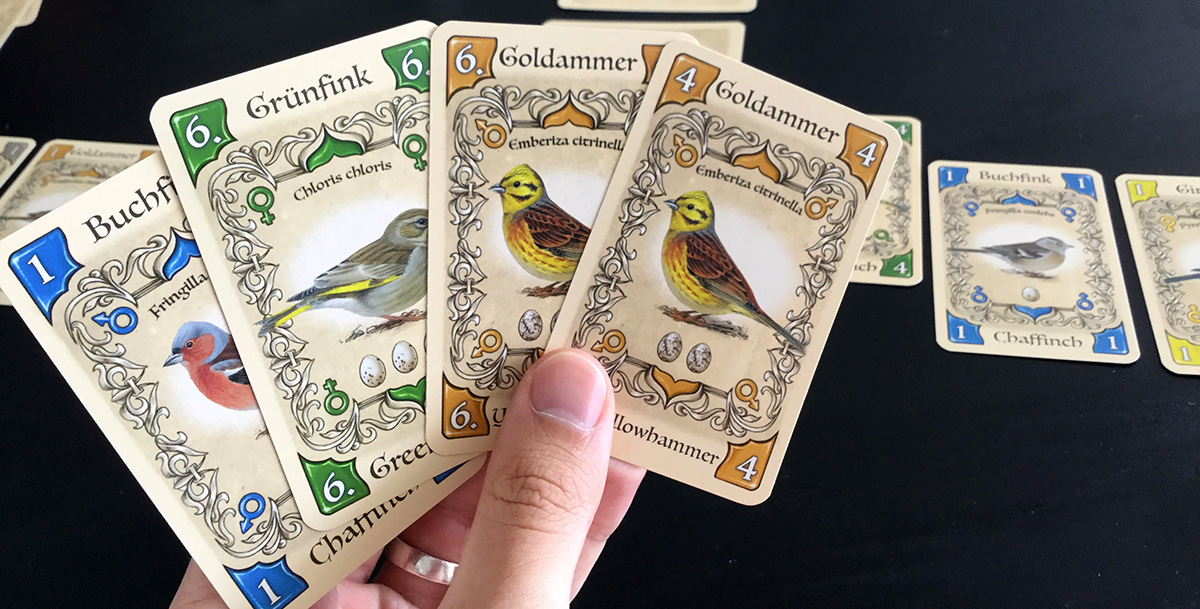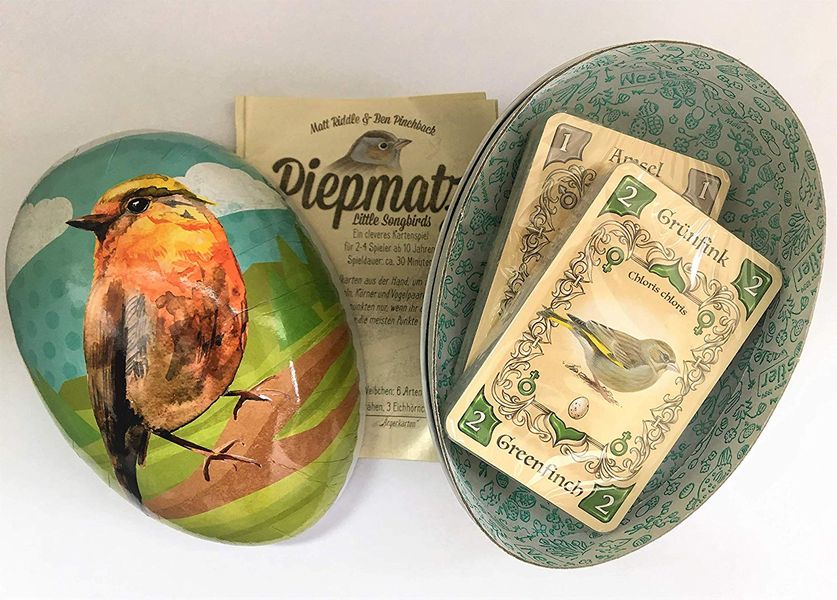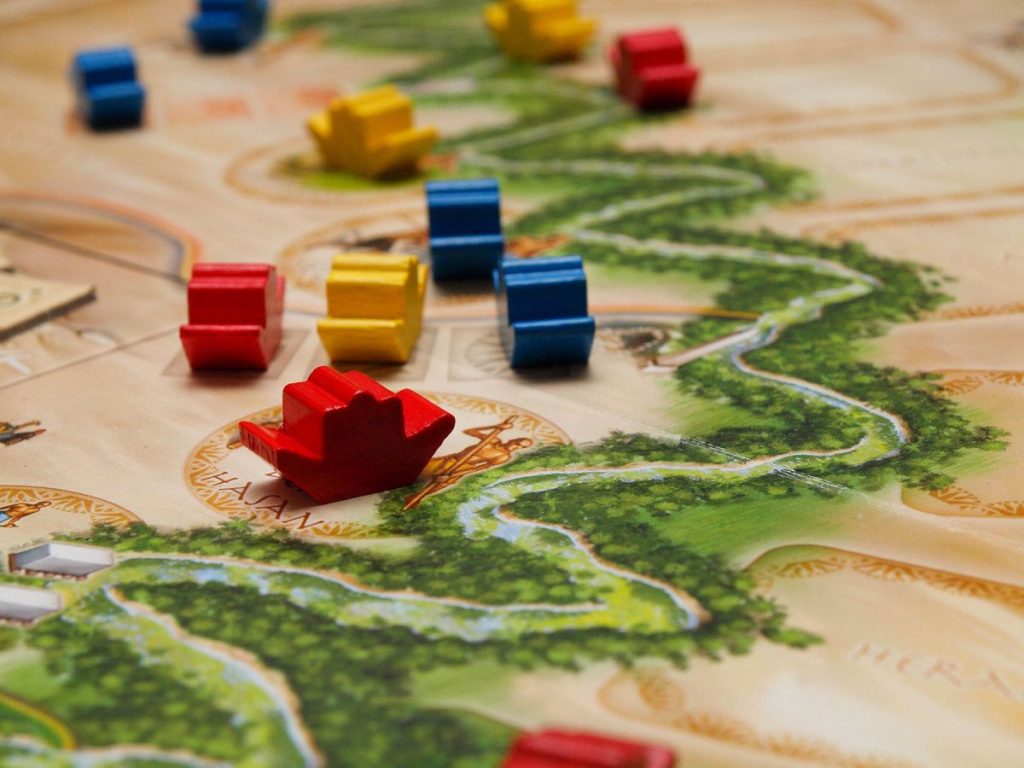Quinns: Piepmatz is a profoundly beige card game for 2-4 players about songbirds fighting over a bird feeder. Now, I should be up front- this game is not a best-in-show card game, as I talked about in my recent 6 Nimmt review.
But you know what? I think it comes very close indeed. I’ve loved my time with it, and it’s now nesting in my game collection.
Let me tell you how it works. This design’s a little fussy, so bear with me. “Pretty rough teach on this one,” as I learned never to say on podcast #89.
Here’s what a game of Piepmatz looks like in progress:
Do you see? It’s a vertical bird feeder, with some birds crowding around the bottom.
To begin the game, players are each given a hand of four bird cards. On your turn you’re going to drop a bird from your hand at one of the perches at the feeder, and at the end of your turn you’ll pick up a replacement bird from a separate ‘display’ of bird cards.
It’s what happens at the bird feeder that scores you points… Or sometimes loses you points. Now, pay attention! Don’t let the teach buck you off, as if you were a six year old boy on the back of a hog that was in turn balanced on a mechanical bull.
Grip tight! Focus!
At each perch of the bird feeder the biggest bird (meaning, the highest numbered card) will fly to the front of the line, with a queue of smaller birds waiting in a row behind them.
IF, AND ONLY IF, the bird you dispatched to the feeder causes the total value of queueing birds to be higher than the value of the bird at the perch, the social pressure becomes TOO MUCH for that big bird. This bird then leaves and flies straight to your personal “scoring area”, and you collect some seed from the bird feeder based on how much you overshoot their value. So, if a value 3 bird is driven off by birds with a total value of 5, you collect the second seed card in the feeder, because 5 minus 3 is two. It’s also worth mentioning that seed cards can range from 1-3 points, so you’ll need to play with precision to receive the most calorific morsels.
Then the biggest bird in the line flexes its way forward to perch at the feeder, but the exact same thing might happen to them- if their value is still lower than the total of the queue, you’ll also add this bird to your scoring area and get yet another seed in a cascade of points and avian anxiety.
HOWEVER, if the bird you send to the feeder on your turn is too small to dislodge the bird at the front of the line, you instead get a consolation prize- you can choose a bird in your hand that’s the same size or smaller than the one you sent to the feeder and drop it straight into your scoring area.
When the bird feeder is empty of seeds, the game ends. The player with the most points wins!
…and then, with a heavy heart, you tell your assembled group of players that you need to explain about scoring.
Above you can see what a player’s scoring area might look like at the end of a game. I’m going to be a bit thuggish now and use bullet points. At the end of the game:
- Everyone gets points for their seeds
- Everyone gets points for each male and female breeding pair of the same species
- For each species you check which player owns the most birds, and that player adds together their numerical value, divides by two, and gets that many points.
And there, that last rule? That’s the game. Like the superb card games Parade and Arboretum, players are scrabbling to collect cards, but the entire game is tinged with dread because it might all be for nothing. Yes, that’s a mighty impressive flock of blackbirds you’ve collected, making blackbirds function as blank cards (blankbirds?) for everyone else at the table. But you can only relax for as long as you can be sure that you’ll still have more blackbirds than anyone else at the end of the game.
And so, Piepmatz enjoys an atmosphere of progress, but also tension. You’re adding to your score every single turn… probably?
Besides this, the strategy in Piepmatz revealed itself to me in increments, lending it a quiet mystery that kept me coming back for game after game. Behind the black, glassy eyes of this game is an intelligence greater than you first suspect.
For one thing, the choice of which card to add to your hand at the end of your turn (or even which card to use to nudge a prize from her perch) might seem inconsequential, but you’ll come to realise that you’re actually seeding* the game with the birds that will eventually end up in people’s scoring areas. Yes, you’re king of the cardinals now. But if you keep sending cardinals to the bird feeder under the assumption that they’re useless to the other players, an opponent might start deliberately collecting them and challenge you for that pointy red crown.
Also, filling your hand with great big birds that will arrive at the bird feeder like a wrestler sprinting towards the ring is going to be great for dislodging other birds and giving you seeds, but we need to talk about crows and squirrels!
This is actually my favourite part of the game. There are crows and squirrels shuffled into the seed deck that will eventually take an interest in the crunchy kernels in your bird feeder. They’re always going to arrive at some point in your game, and players might spent half the game nervously anticipating them.
Squirrels and crows, you see, turn the whole game on its head. When they show up they attach themselves to seed cards and then brutalise any player who ends up taking that seed. Squirrels mug you for further seeds (losing you as much as 10% of your final score), and taking a crow scares away one of the birds in your biggest collection- meaning, whatever species you were leading the table in, whether you’re boss of the blackbirds or baron of sparrows, now they might not score at all.
And this leads to a wicked pivot about half-way through a game of Piepmatz. Suddenly the bird feeder is clogged with crows, and this goes from a game of batting birds around left and right to trying not to disturb anything. I want to say that there are shades of Blackjack in this, with nobody wanting the bird queue to go bust on their turn, but it honestly just reminds me of Don’t Wake Dad and I don’t entirely know why.
The point is that savvy players will prepare for this very moment. If you seed** your hand with low cards in preparation for these nasty animals, then you can simply enjoy the show when the squirrels show up, because they won’t bother you.
Or maybe you’ll choose to tussle with a squirrel, because it might not be that bad! Losing two seed cards at random means you could lose 2 points, you could lose 6. Are you feeling lucky? And for all of the subtle strategy in Piepmatz, this is one of my favourite things about it. This is a very clever game and it’s not the easiest to teach, but it has all of these sumptuous little zones where you can turn off your brain and just gamble, as if you were turning off your car’s engine to coast down a hill.
If you dislodge a bird and the difference is more than 4, you don’t draw any of the 4 cards in the feeder but instead draw blindly from the top of the deck, and it could be a crow. If you don’t like any of the birds in the display, you can take a chance by drawing blindly from the top of the deck, just like in Ticket to Ride. And at the end of the game, players pick 2 birds from their hand to add to their collection, just like in Parade, which means Piepmatz always ends in a spicy showdown.
But if Piepmatz’ strategy is unobvious, its flaws *are* obvious. As I said before, it’s fussy. It’s a fussy thing to play.
So much of the joy of card games is in the delicate tactility of holding (and fanning) a hand of cards, and simply flattening them and flipping them on the table. Piepmatz comes pretty close to frustrating this because of the breadth of admin that you have to perform on your turn. Once you’ve played a card on your turn, this card then moves other cards, then you pick up a card, then another, then a third card, all of which go in different places, THEN you reveal a new card from the top of two decks. If you’re not playing on a fabric surface, that’s a lot of cards to try and get your fingernails underneath.
Also, while the pictures of the birds from artist Ben Pinchback are perfectly lovely, Klemens Franz’ art design – the card backs, the templating, the relentless oatmeal-iness of it all – is so weak as to almost feel like sabotage. Piepmatz clearly wants to look elegant and distinctive, but it ends up looking alternately plain, inelegant, and even repulsive. Who decided on two different shades of weird wrought iron cardbacks? And who chose to dress the sparrows in Pepto-Bismol pink?!
But I don’t really care. That’s the nice thing about card games. Nobody expects the world from them, and this one especially takes up hardly any space at all. Piepmatz might be a hard game for me to tell you to go out and buy, but once I was done taking photos of it I slipped it straight into my card game collection without a second thought. Like a nest in a tree, I might not see it often, but it’s intricate, beautiful, and I’m happier knowing it’s there.
DISCLAIMER: Just don’t buy the edition that comes in a big egg.
Did you think I was joking? I’m not. There it is. Game and egg in one unholy package. It’s like someone at Lookout Games turned to his colleague and said “You know the problem with board game boxes? They’re don’t wobble enough.”
Probably do not buy the egg edition.
That is all.
Thanks.
*Pun intended
**Pun not intended











